A comprehensive account, with pictures and
observations, of the seven days we spent in the Himalayan Kingdom of Bhutan.
Patience and respect for tradition is everywhere.
It is a different World when you crossover from
Jaigaon, West Bengal to Phuentsholing, Bhutan. Leaving behind chaos, crowds and
cacophony, you suddenly step into a place synonymous with peace, patience,
happiness and people with smiling faces welcoming you. Instead of flying into
Paro, an option available only from Delhi on certain days of the week, we
decided to fly to Bagdogra and do a four hours drive to the border town of
Phuentsholing.
Soon we were to realize that nobody
honks in a country that boasts managing its traffic without a single
traffic light! With a population of just 8 lakhs and an economy driven by
agriculture, hydro and tourism, this hill country has figured out a way to
attract only serious tourists by imposing a fee of Rs 1200/pax/day for Indians
that you initially resist but soon feel good when you are told that tourists
from other countries pay $ 200/pax/day.
Taking a local guide is mandatory who helps you in
connecting with everything local. Indian currency is accepted everywhere at 1:1
with local currency Nu also available in exchange.
Bhutanese take pride in telling you that the education
at all levels and medical for them whether in Bhutan or elsewhere in the World,
if needed, is totally funded by the state. Our guide was also quick to tell us
that their king lives in a small house without putting unnecessary pressure on
country finances. By not being in any race (armed forces number is under 7,000)
and instead focused on promoting harmony and happiness, Bhutan seems to have
given its people a reason to cheer.
Bhutan is a country that borders only China and India,
but you feel great when you see Indian goods, cars and services everywhere.
They even have an Indian army base in Punakha and we were told that we could get
hot samosas and jalebis from the army canteen to satisfy our cravings!
We, like in the past, used the services of Surabhi at
Routed Travels to chalk out a one-week plan for us and that meant our program
getting restricted mainly to the most visited cities of Paro, Punakha and
Thimphu. Additional 4-5 days can help you to go towards eastern side though it
is still not fully open after the pandemic. For bird lovers, the right winter season
can mean spotting Himalayan black-necked Cranes particularly in Phobjikha
valley around Bumdeling.
Day 1
Reaching Bagdogra by noon and then 4 hours to Jaigaon
by a pre-arranged Innova that goes mostly through plain roads along tea
gardens. Crossing over to Phuntosholing is allowed for Indians to stay the
night, without stamping of the passports. Walking in the city, seeing the
Buddhist temple in centre of the town and just absorbing the change over to a
different country were the highlights of the day.
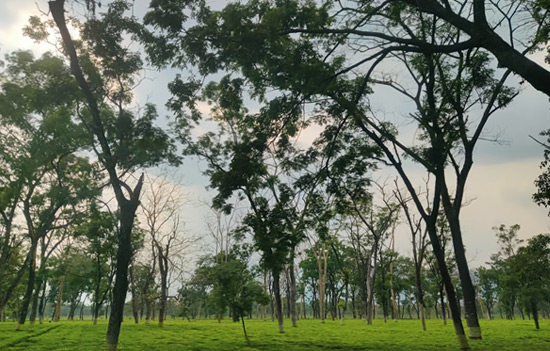 Tea gardens en route to Jaigaon.
Tea gardens en route to Jaigaon.
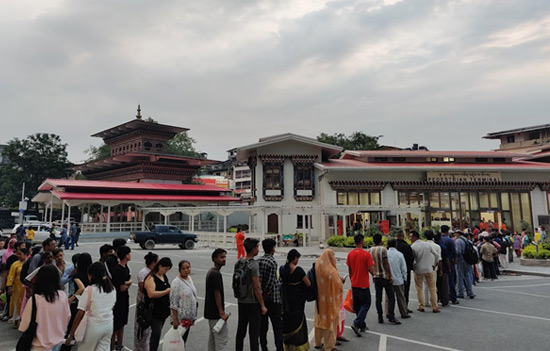 A very organized Phuentsholing, across the border.
A very organized Phuentsholing, across the border.
Day 2
Next morning, it takes about an hour to complete all formalities of stamping a permit on the passport for a formal entry in Bhutan which gets checked en route later in the day. From Phuentsholing, we drove straight to Paro, stopping en route to pay respects at chortens (stupas) that come aplenty on the way and a stop for lunch. Paro has a suspension bridge and a dzong (fortress) and an airport on the outskirts for which you need some really good pilots to land. The market has nice cafes (Mountain Café is recommended) and shops to check out.
As we had chosen Naksel, a very nice property 1-2 kms from the town and close to a forest, we decided to explore this beautiful hotel nicely spread out. A drink in the bar facing the mountains all around followed by a cozy dinner in this elegant place felt heavenly. There are several options for stay in Paro – from being close to the market in a decent place to luxurious properties that are allowed a little outside the main town.
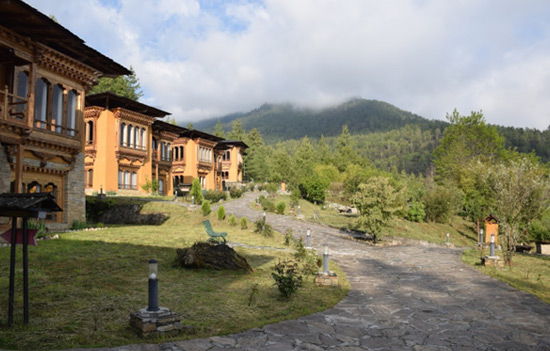 Naksel with a splendid view.
Naksel with a splendid view.
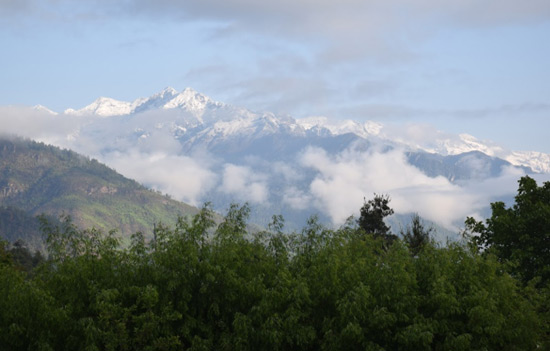 Naksel with a splendid view.
Naksel with a splendid view.
See album on Paro
Day 3
Having got acclimatized to the region, we were ready to do a five km trek (one way) to Tiger’s Nest monastery, arguably the most important spot in Bhutan. Also known as Paro Takstang, the Tiger’s Nest dates back to the 17th century.
The most iconic place where the monastery can be seen
hanging on the side of a cliff is a Vajrayana Buddhist site where, as per the
legend, Guru Padmsambhava who is credited to having introduced Buddhism in
Bhutan, flew to this location on the back of a tigress to get rid of a demon in
the 7thcentury.
A steep five km climb, considered moderate to
difficult, results in gaining over 1200 meters in height half of which can be
done on a pony where at mid-way, a restaurant is located serving food and
beverages. There are nine beautiful temples in the monastery with exquisite
wall paintings, eight of which are open to the public. Photography inside is
not permitted.
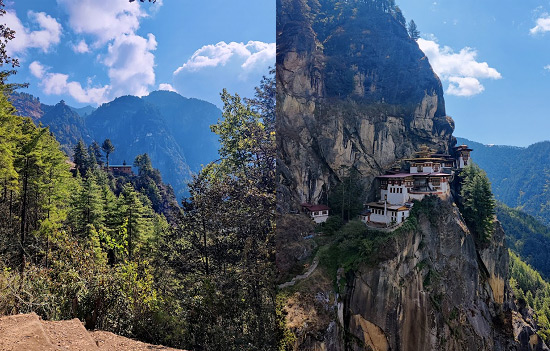 The steep climb to Tiger Nest, perched on a cliff.
The steep climb to Tiger Nest, perched on a cliff.
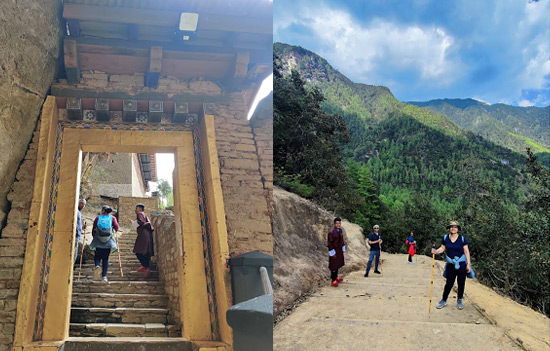 The steep climb to Tiger Nest, perched on a cliff.
The steep climb to Tiger Nest, perched on a cliff.
Having done the hike, we were back by 3 PM to enjoy a
hot stone bath to rejuvenate ourselves, practice a bit of archery, the national
sport, before venturing into the market for some local cuisines and shopping.
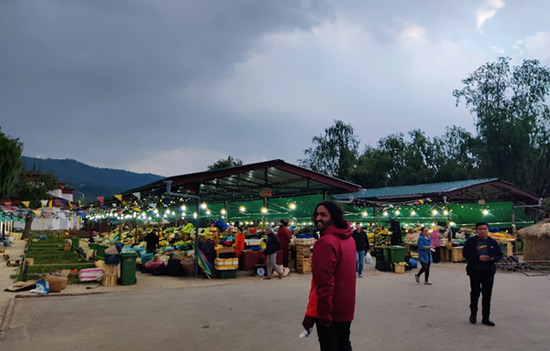 A well-organized farmers market.
A well-organized farmers market.
Day 4
We managed to do some birding early in the morning
around the forest and on the river in Paro spotting around 20 different birds
including magpies, oriental turtle dove, shrikes, bulbuls, grey crested tit,
drongo, chough, etc. The area around the river is serene and standing on the
bridge looking for birds with the mountains in the background is nothing short
of surreal.
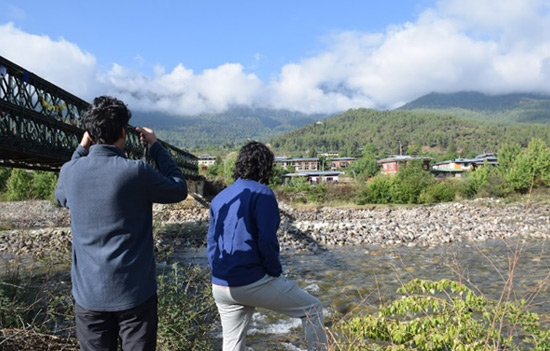 Birding in Punakha.
Birding in Punakha.
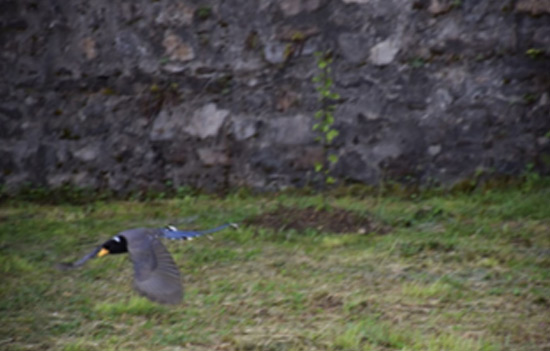 Birding in Punakha.
Birding in Punakha.
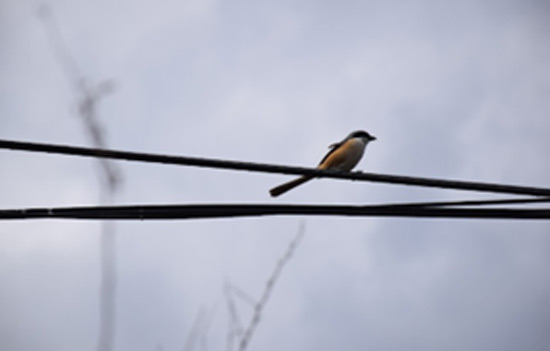
Chelela Pass, at a height of 3988 meters, is better known for being the highest point for a
motorable road in Bhutan with some magnificent views of Mt Chomolhari. Having tea and snacks with snowcapped mountains as a backdrop, en
route to Haa Valley day visit, made a perfect stop for us. One can see Paro
valley on one side and Haa valley (located at 2670 meters altitude, just 13
miles from Doklam and opened to tourism only a few years back) on another from
this pass.
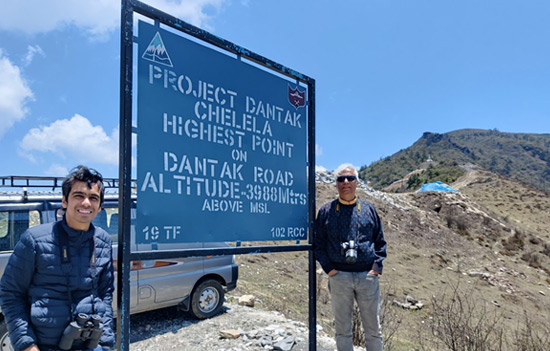 Author.
Author.
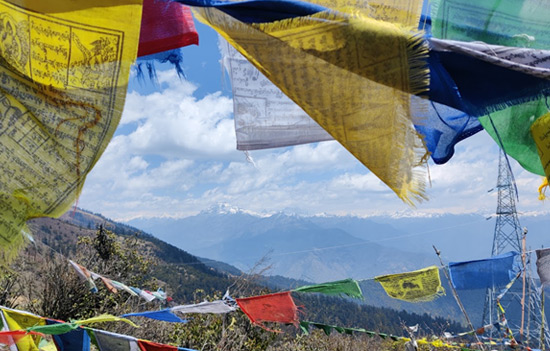 At Chelela pass.
At Chelela pass.
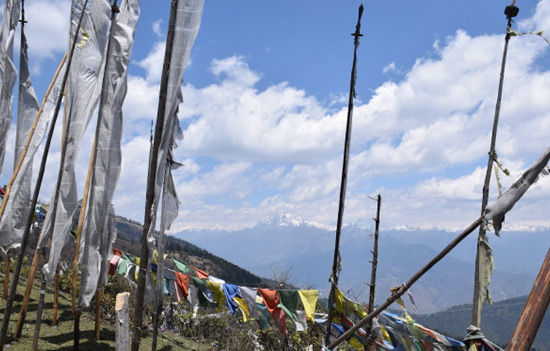 At Chelela pass.
At Chelela pass.
Haa Dzong can be seen as you start climbing down to
the valley, but the town is best known for some stunning views and the 7thcentury
Lhakhang Karpo (white temple) and Lhakhang Nagpo temples (black temple). Local
tradition has it that the Tibetan King in the 7thcentury set free two
doves, a white and a black, and the temples were built at places where these
doves decided to settle. Built at the foot of the sacred mountains, the white
temple particularly, is a stunning site and therefore a must visit monument.
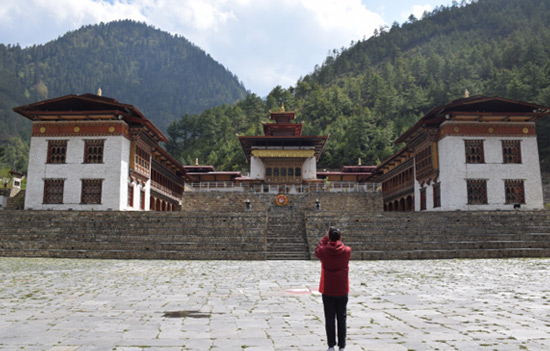 Lhakhang Karpo temple, Haa Valley.
Lhakhang Karpo temple, Haa Valley.
We had the opportunity to relish a local delicious
lunch at Kinley Wangchuk homestay here which turned out to be one of the best
meals we had in Bhutan.
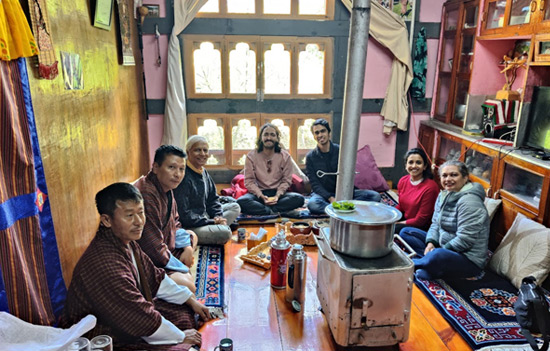 Lunch at Kinley Wangchuk homestay.
Lunch at Kinley Wangchuk homestay.
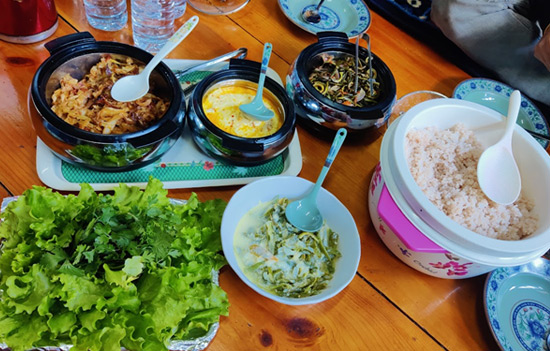 Our lunch spread-delicious vegetarian meal.
Our lunch spread-delicious vegetarian meal.
The Bhutanese use a lot of greens, chilies and
cheese in their vegetarian cooking and it is a delight for those who cherish
them. We really enjoyed Ema Datshi made of chilies and cheese, Kewa Datshi,
fiddlehead ferns along with Suja, the salty tea at this place.
Day 5
The four hour drive from Paro to Punakha goes through
Dochula pass, a stunningly beautiful point at 3100 meters from where one can
see several snowcapped peaks including Gangkar Puensum, the highest mountain in
Bhutan i.e. at 7300 meters. The 108 memorial chortens build recently to commemorate
a victory over insurgents, the caves at a short distance and the surreal
atmosphere here compels you to admire the nature all around.
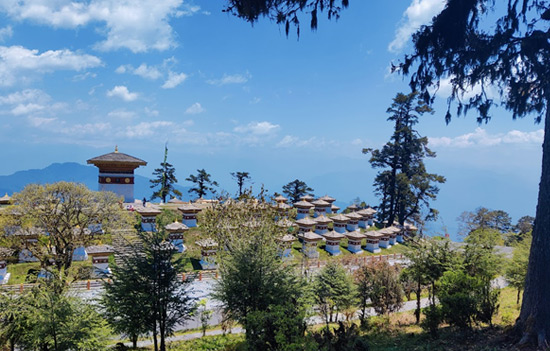
Punakha dzong located at a confluence of two rivers,
also popular for rafting, is arguably one of the best dzongs and one of the
most majestic sights in the country. Surrounded by purple jacaranda flowering
trees and connected by a bridge over the river, the dzong is the second largest
and second oldest dating back to 17th century. Before Thimphu, the
capital was Punakha and the administrative seat was the dzong.
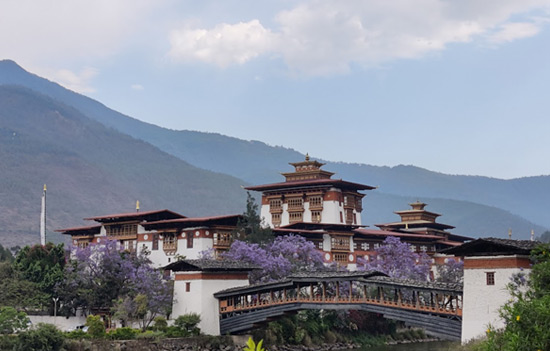 Punakha dzong.
Punakha dzong.
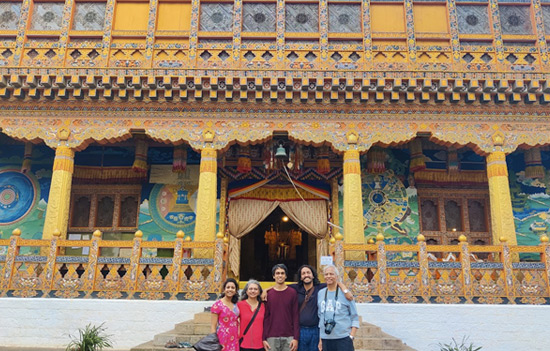 The temple inside the dzong
The temple inside the dzong
Punakha, at 1200 meters, is very pleasant and also boasts of having Amankora resorts, a super luxury and super expensive property chain where we had our lunch sitting under the trees amidst nature. A 180 meters long Punakha suspension bridge over the Po Chhu river is the longest suspension bridge in Bhutan and walking over it provides a great opportunity to soak in the river views with mountains as the backdrop.
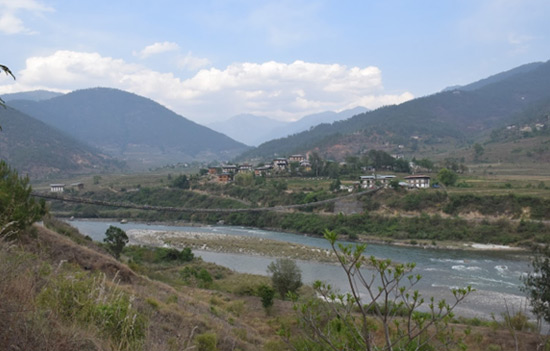 The suspension bridge, Punakha.
The suspension bridge, Punakha.
At night, the dzong is well lit and staying in a property that gives you views of the dzong is something that we truly enjoyed.
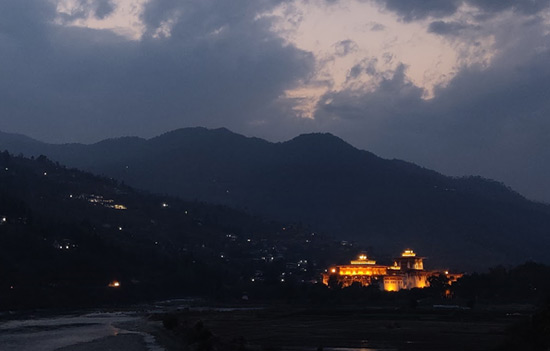 The night view of Punakha dzong.
The night view of Punakha dzong.
To see album on Punakha
Day 6
Located just fifteen minutes away from Punakha is a unique phallic temple where people believe that the
blessings by a centuries old wooden phallus kept in the temple can result in
fertility for childless parents. Known as Chimi Lhakhang, the site, on which it
was built in the year 1499, was blessed by a divine madman, Drupka Kunley.
It is said that he had subdued a demon here and he then
taught Buddhism using unorthodox and funny ways using bizarre and shocking
sexual overtones including blessing people with the wooden phallus. You can see
open use of phallus everywhere in this area including on artefacts, souvenirs
and paintings.
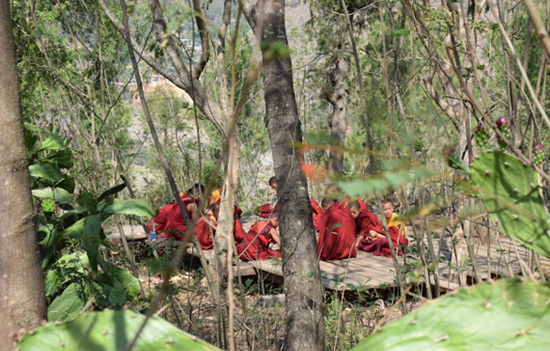 Young monks praying near the phallic temple.
Young monks praying near the phallic temple.
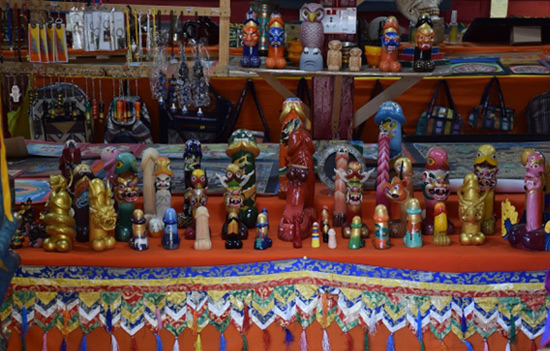 In a shop nearby - Celebration of the phallus at its creative and colorful best.
In a shop nearby - Celebration of the phallus at its creative and colorful best.
Thimphu, the capital of Bhutan is just under 3 hours
from Punakha and is highly underrated. Green rooftops are all residential
buildings here while those in red are institutions.
Also
read What
is Siva Linga
As soon as you enter Thimphu, you can see the large 169-foot-tall
Buddha statue on a mountain, smiling at you from every corner. A visit to the
statue is a must just to appreciate the enormity of it. Inside the statue are
installed 125,000 small Buddhas that we all can visit and see.
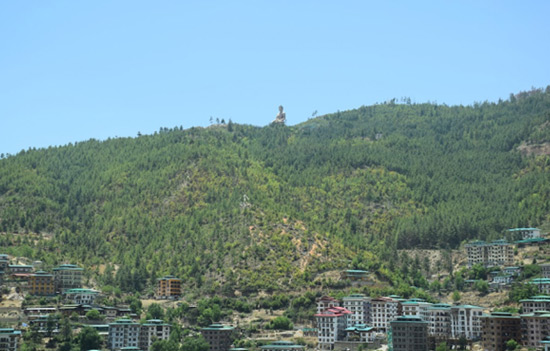 Beautiful Thimpu city.
Beautiful Thimpu city.
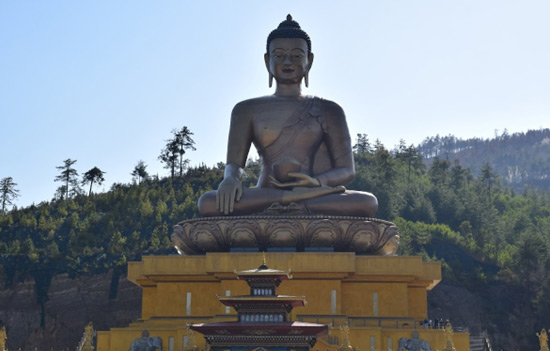 Giant Buddha in Thimpu.
Giant Buddha in Thimpu.
Besides nice cafes and restaurants with live music, Thimphu has some interesting museums – Stamp Museum in GPO uniquely describes the evolution of postal system while the folk heritage museum shows Bhutanese culture and their way of life, besides housing a really good café serving local cuisine where we enjoyed a great lunch.
Textile museum close by showcases the different styles of Bhutanese
attire including Gho and Kira, the national dress for men and women. A handmade
paper factory gives you a glimpse into how paper is made from pulp and each how
each sheet is manually dried before converting into a commercial paper.
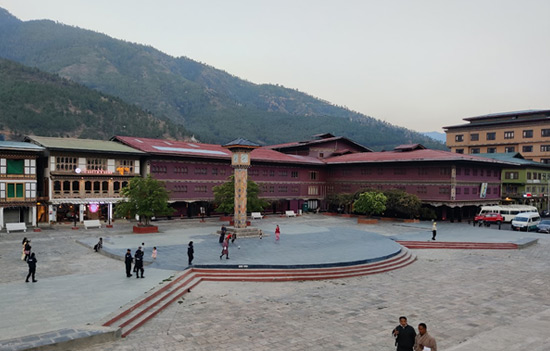 Clock tower in Thimphu.
Clock tower in Thimphu.
The Thimphu Dzong can be seen from a distance and
close to that is a modest house where the current king stays with his family.
We chose to do cafe and bar hopping on our last
evening in Bhutan and spend some time just walking in the Thimphu bazars and
enjoying variety of food with some live music. A great way to end our trip in
Bhutan!
To see album on Thimpu
Day 7
We had booked to stay the night at Kalimpong in West Bengal (9 hours from Thimphu via Phuentsholing for exit formalities) before catching the flight the next day and for that we had to leave after a quick breakfast.
However, in hindsight,
spending another half day in Thimphu would be ideal before heading to
Phuentsholing and breaking the journey there. That means 4-5 hours of driving
time which one can do with a comfortable check out.
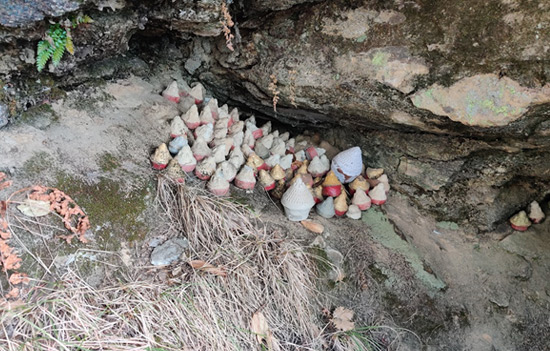 Little stupas containing ash of the dead are left on the mountains as a ritual.
Little stupas containing ash of the dead are left on the mountains as a ritual.
Day 8
A four hour drive from Kalimpong took us back to
Bagdogra for our return flight to Mumbai.
If one chooses to stay at Phuentsholing, the drive to
Bagdogra shall also be around 4 hours.
Observations on Bhutan
Is Bhutan modernizing or is it still frozen in time?
Does it source its strength from its own culture or whether it depends upon its
neighbors? Is it opening up to a democratic rule or monarchy is the way to go
for Bhutanese people? j
There's a strong sense of an independent identity - distinct from India for sure but also from Tibet, from whom a lot of cultural artefacts are borrowed. There's an investment in public spaces and infrastructure (e.g. on our Trek up to Taktsang, paths were generally well-marked and a restaurant along the way). Karaoke and K pop is becoming popular.
Having said that, there is an appreciation and respect for tradition as it shows up in architecture.
Most buildings we saw were decorated with elaborate and ornate facades
(painted), and either adhered to or derived from the traditional architectural
style. The food was also seen to be its own thing while the patience is seen
everywhere – whether in queuing up or attending to a mishap on the road!
So, in summary, the answers to all the questions is
that Bhutan is trying to balance the positives from each of these while
retaining its simplicity and abundance of natural beauty.
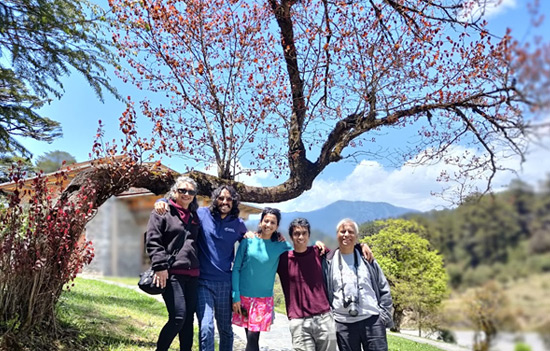 Happy faces at the end of our trip.
Happy faces at the end of our trip.
To
read all travelogues by author
Also read Driving
to Bhutan the Land of Gross National Happiness